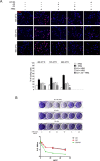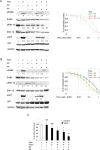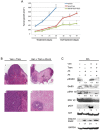Combination of antibodies directed against different ErbB3 surface epitopes prevents the establishment of resistance to BRAF/MEK inhibitors in melanoma
- PMID: 26208478
- PMCID: PMC4694796
- DOI: 10.18632/oncotarget.4485
Combination of antibodies directed against different ErbB3 surface epitopes prevents the establishment of resistance to BRAF/MEK inhibitors in melanoma
Abstract
Patients with metastatic melanoma bearing V600 mutations in BRAF oncogene clinically benefit from the treatment with BRAF inhibitors alone or in combination with MEK inhibitors. However, a limitation to such treatment is the occurrence of resistance. Tackling the adaptive changes helping cells survive from drug treatment may offer new therapeutic opportunities. Very recently the ErbB3 receptor has been shown to act as a central node promoting survival of BRAF mutated melanoma. In this paper we first demonstrate that ErbB3/AKT hyperphosphorylation occurs in BRAF mutated melanoma cell lines following exposure to BRAF and/or MEK inhibitors. This strongly correlates with increased transcriptional activation of its ligand neuregulin. Anti-ErbB3 antibodies impair the establishment of de novo cell resistance to BRAF inhibition in vitro. In order to more potently ablate ErbB3 activity we used a combination of two anti-ErbB3 antibodies directed against distinct epitopes of its extracellular domain. These two antibodies in combo with BRAF/MEK inhibitors potently inhibit in vitro cell growth and tumor regrowth after drug withdrawal in an in vivo xenograft model. Importantly, residual tumor masses from mice treated by the antibodies and BRAF/ERK inhibitors combo are characterized almost exclusively by large necrotic areas with limited residual areas of tumor growth. Taken together, our findings support the concept that triple therapy directed against BRAF/MEK/ErbB3 may be able to provide durable control of BRAF mutated metastatic melanoma.
Keywords: Anti-ErbB3 antibodies; BRAF/MEK inhibitors; ErbB3 activation; in vivo regrowth impairment; melanoma.
Conflict of interest statement
L.F., D.M., A.N., C.D.V., M.E.P., P.C., R.C., M.R.T., R.M., and G.C. declare no conflict of interest.
E.M., G.R. and L.A. are employees of Takis S.r.l.
A.R. served as consultant for Amgen, Genentech-Roche, GSK, Merck, Novartis and Pierre Fabre with the honoraria paid to UCLA. He has stock in Kite Pharma and Compugen.
P.A.A. served as consultant/for BMS, Roche-Genentech, MSD, GSK, Ventana, Novartis, and Amgen. He received research funds from BMS, Roche-Genentech, Ventana.
Figures







Similar articles
-
Function-blocking ERBB3 antibody inhibits the adaptive response to RAF inhibitor.Cancer Res. 2014 Aug 1;74(15):4122-32. doi: 10.1158/0008-5472.CAN-14-0464. Epub 2014 Jul 17. Cancer Res. 2014. PMID: 25035390 Free PMC article.
-
Activation of an early feedback survival loop involving phospho-ErbB3 is a general response of melanoma cells to RAF/MEK inhibition and is abrogated by anti-ErbB3 antibodies.J Transl Med. 2013 Jul 27;11:180. doi: 10.1186/1479-5876-11-180. J Transl Med. 2013. PMID: 23890105 Free PMC article.
-
Overcoming acquired BRAF inhibitor resistance in melanoma via targeted inhibition of Hsp90 with ganetespib.Mol Cancer Ther. 2014 Feb;13(2):353-63. doi: 10.1158/1535-7163.MCT-13-0481. Epub 2014 Jan 7. Mol Cancer Ther. 2014. PMID: 24398428
-
The role of MEK inhibitors in the treatment of metastatic melanoma.Curr Opin Oncol. 2014 Mar;26(2):196-203. doi: 10.1097/CCO.0000000000000050. Curr Opin Oncol. 2014. PMID: 24419498 Review.
-
Trametinib in metastatic melanoma.Expert Rev Anticancer Ther. 2015;15(7):749-60. doi: 10.1586/14737140.2015.1060127. Expert Rev Anticancer Ther. 2015. PMID: 26107021 Review.
Cited by
-
Future perspectives in melanoma research: meeting report from the "Melanoma Bridge": Napoli, December 3rd-6th 2014.J Transl Med. 2015 Nov 30;13:374. doi: 10.1186/s12967-015-0736-1. J Transl Med. 2015. PMID: 26619946 Free PMC article.
-
Synergistic antitumor activity of histone deacetylase inhibitors and anti-ErbB3 antibody in NSCLC primary cultures via modulation of ErbB receptors expression.Oncotarget. 2016 Apr 12;7(15):19559-74. doi: 10.18632/oncotarget.7195. Oncotarget. 2016. PMID: 26862736 Free PMC article.
-
Mechanisms of Acquired BRAF Inhibitor Resistance in Melanoma: A Systematic Review.Cancers (Basel). 2020 Sep 29;12(10):2801. doi: 10.3390/cancers12102801. Cancers (Basel). 2020. PMID: 33003483 Free PMC article. Review.
-
Dissecting Mechanisms of Melanoma Resistance to BRAF and MEK Inhibitors Revealed Genetic and Non-Genetic Patient- and Drug-Specific Alterations and Remarkable Phenotypic Plasticity.Cells. 2020 Jan 7;9(1):142. doi: 10.3390/cells9010142. Cells. 2020. PMID: 31936151 Free PMC article.
-
HER3 in cancer: from the bench to the bedside.J Exp Clin Cancer Res. 2022 Oct 21;41(1):310. doi: 10.1186/s13046-022-02515-x. J Exp Clin Cancer Res. 2022. PMID: 36271429 Free PMC article. Review.
References
-
- Balch CM, Gershenwald JE, Soong SJ, Thompson JF. Update on the melanoma staging system: the importance of sentinel node staging and primary tumor mitotic rate. J Surg Oncol. 2011;104:379–85. - PubMed
-
- Korn EL, Liu PY, Lee SJ, Chapman JA, Niedzwiecki D, Suman VJ, Moon J, Sondak VK, Atkins MB, Eisenhauer EA, Parulekar W, Markovic SN, Saxman S, et al. Meta-analysis of phase II cooperative group trials in metastatic stage IV melanoma to determine progression-free and overall survival benchmarks for future phase II trials. J Clin Oncol. 2008;26:527–34. - PubMed
-
- Menzies AM, Long GV. Systemic treatment for BRAF-mutant melanoma: where do we go next? Lancet Oncol. 2014;9:e371–81. - PubMed
Publication types
MeSH terms
Substances
LinkOut - more resources
Full Text Sources
Other Literature Sources
Medical
Molecular Biology Databases
Research Materials
Miscellaneous

